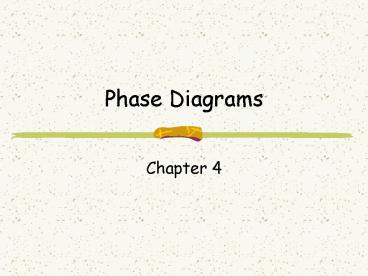Phase Diagrams
1 / 33
Title: Phase Diagrams
1
Phase Diagrams
- Chapter 4
2
So far.
- We have concentrated on the plastic deformation
of a pure metal. - We have looked at strengthening approaches (cold
work) that do not require that we change the
composition of the metal. - In this chapter we start to examine alloying, and
see why alloys are stronger than pure metals
3
Why Alloys?
- The existence of two or more phases can
strengthen a material - Usually pure metals are soft materials
- Alloying element present in smaller amounts
(most steels contain less than 1 of carbon)
4
Lets Start with a basic question.. What is a
phase?
- Homogeneous in crystal structure and atomic
arrangement - Same physical and chemical properties
- A definite interface with its surroundings
- Mechanically separable
5
Solution and Solubility
Example Solubility of salt in water There exists
a maximum amount of salt that can be completely
dissolved in water excess of salt stays as
solid. This maximum amount is the solubility of
salt in water. The solution containing the
maximum concentration of salt is a saturated
solution. Cooling of saturated solution results
in the formation of solid salt from the
solution, indicating that solubility decreases
with decreasing T. This process is called
precipitation and the solid formed is a
precipitate. Heating the solution will lead to
the dissolving of the precipitate back into
solution.
6
The same concepts apply to solids solid
solution, saturation, solubility, precipitation
- In this example there exist two phases in the
system and the two phases stay in equilibrium
7
For example
- A glass of ice water has two phases
- Solid water phase
- Liquid water phase
- A mixture of salt and pepper has two phases
- Solid salt
- Solid pepper
8
Solid, Liquid or Gas?
- We usually think of matter as having 3 phases,
but.. - Its possible to have more than one solid phase.
- For example
- when iron first freezes it is BCC
- As it cools it changes to FCC
- Upon further cooling it changes to BCC
9
Phase Diagram
- A visualization technique to help you see where
different phases exist, based on state variables
Liquid
Pressure
Solid
Gas
Temperature
10
Mapping for a temperature-composition equilibrium
phase diagram
11
Cooling Curve for a Pure Metal
Temperature
Time
12
Forms in which Alloys Exist
- Solid solutions
- Compounds
- Mixtures (e.g. bird feed)
13
Intermetallic Compounds
- Often alloying elements form with the host
intermetallic compounds metals that are
chemically bonded to each other - They are hard and brittle
- Give the alloy strength, wear resistance and
hardness
14
Solid Solutions
- Solubility of one metal in another occurs at the
atom-lattice level - Can be substitutional or interstitital
15
Substitutional Solid Solution
Solute atoms displace the host atoms
16
Substitutional Solid Solution
- Possible only if the atoms have close atomic
diameters
17
Interstitial Solid Solution
Solute atoms are located between the atoms of
the host metal
18
Guidelines
- Host metal should be soft to provide ductility
- Alloying metal should be hard to provide strength
more precipitate results in higher strength - Precipitate should be discontinuous
19
Guidelines
- Smaller, more numerous precipitate particles give
higher strength because they interfere with slip - Round particles are better than sharp particles
Sharp particles can initiate a crack
20
Type 1 solid solution alloys
- Completely soluble in each other in solid and
liquid states - Difference in the atoms sizes should be less that
15 - Similar chemical properties
- Similar crystal lattice
21
Cooling Curve of Pure Metal
Freezing takes place at a constant temperature,
during freezing the latent heat of solidification
is given off.
22
Cooling curves determination of phase diagrams
II
1455?C
Liquid
1085?C
Liquidus
T
T1
(thermal arrest)
Solidus
LS
T
T2
Solid
I
1085?C
T1
T
II
I
III
T2
Cu
Ni
t
23
1455?C
liquid phase - Solution of Cu and Ni
The simplest type of binary phase diagrams is the
Type I system, in which the two metals form a
continuous solid solution over the entire
composition range. An example is the Ni-Cu
system.
T1
Co
CS1
CL2
T2
Temperature
CS2
CL3
T3
Co
Solidification of alloy Co starts on cooing at
T1. The first solid formed has a composition of
Cs1 and the liquid Co. On further cooling the
solid particles grow larger in size and change
their composition to Cs2 and then Co, following
the solidus whereas the liquid decrease in volume
and changes its composition from Co to CL3
following the liquidus. The solidification
completes at T3.
- phase (FCC) Solid solution of Cu and Ni
1085?C
Cu
Ni
Composition
L
a
24
Type II Eutectic Alloys
Partial equilibrium diagram for NaCl and H2O
derived from cooling-curve information
25
How Does the Solid Form?
26
Type III Terminal Solid Solution
- Completely soluble in the liquid state
- Partially soluble in the solid state
27
(No Transcript)
28
- Lets not look at how the solid forms just yet
its a little complicated - Instead lets look at what happens if your over
all composition is the eutectic composition
29
(No Transcript)
30
Cooling Curve for a Eutectic System
Plumbers solder is a eutectic alloy of Pb and
Sn. Why?
Temperature
Low, sharp melting point
Time
31
How Does the Eutectic Solid Form?
L a b
Eutectic Solids are strong but generally have
little ductility
32
Strength of Eutectic Alloys
- Each phase is solid solution strengthened
- Grain size affects the strength well inoculated
melts have smaller grain size - Interlamellar spacing
33
Interlamellar Spacing
- The spacing is controlled by how long the grains
are allowed to grow - You can limit the spacing by reducing the
solidification time by removing heat faster - Small interlamellar spacing results in high
strength






























